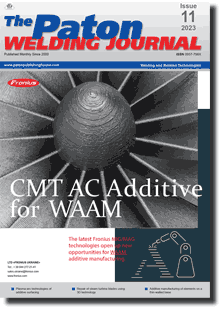| 2023 №11 (03) |
DOI of Article 10.37434/tpwj2023.11.04 |
2023 №11 (05) |

The Paton Welding Journal, 2023, #11, 35-40 pages
Technological methods of controlling the formation of metal deposited by flux-cored wires
A.A. Babinets
E.O. Paton Electric Welding Institute of the NASU. 11 Kazymyr Malevych Str., 03150, Kyiv, Ukraine. E-mail: a_babinets@ukr.netAbstract
Integrated comparative studies of the possibility of controlling formation and properties of metal by changing the electric parameters in single-layer arc surfacing were conducted. The materials used were flux-cored electrode wires of 1.8 – 2.8 mm diameter, which were developed for three conditions of material deposition: in shielding gas atmosphere (GMAW), with open arc (SSAW) and submerged-arc (SAW). Metal part of the wires was designed so as to produce deposited metal of the type of heat-resistant tool 25Kh5FMS steel. Studies were conducted in a broad mode range: current of 150...450 A, and voltage of 20...32 В. The optimal ranges of current and voltage were experimentally determined for each material deposition method and flux-cored wire diameter, which ensure sound formation of the deposited beads, minimal penetration depth and dilution of deposited metal by base metal. Respective dependencies of the influence of current and voltage on the deposited bead geometry were plotted. Obtained experimental data can be used in the processes of additive manufacturing at selection of optimal modes of layer-by-layer arc deposition of metal materials – wire arc additive manufacturing (WAAM) of part elements. 11 Ref., 3 Tables, 4 Fig.
Keywords: arc surfacing, flux-cored wire, control, surfacing modes, deposited metal formationу, deposited bead dimensions
Received: 19.10.2023
Accepted: 07.12.2023
References
1. Ryabtsev, I.A., Kuskov, Yu.M., Pereplyotchikov, E.F., Babinets, A.A. (2021) Surfacing. Control of base metal penetration and formation of deposited layers: Monography. Ed. by I.A.Ryabtsev. Kyiv: Interservice [in Russian].2. The Future for WAAM. https://additivemanufacturing.com/2019/08/27/the-future-for-waam/
3. Wohlers, T. (2014) Additive manufacturing and 3D-printing state of the industry: Annual worldwide progress report, Wohlers Associates.
4. Ding, D., Pan, Z., Cuiuri, D. et al. (2015) Wire-feed additive manufacturing of metal components: technologies, developments and future interests. The Int. J. of Adv. Manuf. Technol., 811(4), 465-481. https://doi.org/10.1007/s00170-015-7077-3
5. Bonaccorso, F., Cantelli, L., Muscato, G. (2011) Arc welding control for shaped metal deposition process. IFAC Proceedings Volumes, 44(1), 11636-11641. https://doi.org/10.3182/20110828-6-IT-1002.01575
6. Ding, D., Shen, C., Pan, Z. et al. (2016) Towards an automated robotic arc-welding-based additive manufacturing system from CAD to finished part. Computer-Aided Design, 73, 66-75. https://doi.org/10.1016/j.cad.2015.12.003
7. Prado-Cerqueira, J.L., Dieguez, J.L., Camacho, A.M. (2017) Preliminary development of a Wire and Arc Additive Manufacturing system (WAAM). Procedia Manufacturing, 13, 895-902. https://doi.org/10.1016/j.promfg.2017.09.154
8. CMT - Cold Metal Transfer: The cold welding process for premium quality. [Електронний ресурс]. Режим доступу: https://www.fronius.com/en/welding-technology/world-ofwelding/ fronius-welding-processes/cmt
9. Cong, B., Ding, J., Williams, S. (2015) Effect of arc mode in cold metal transfer process on porosity of additively manufactured Al-6.3%Cu alloy. The Int. J. of Adv. Manuf. Technol., 76, 1593-1606. https://doi.org/10.1007/s00170-014-6346-x
10. Ryabtsev, I.A., Lankin, Yu.N., Soloviov, V.G. et al. (2015) Computer information-and-measuring system for investigation of arc surfacing processes. The Paton Welding J., 9, 32-35. https://doi.org/10.15407/tpwj2015.09.05
11. Babinets, A.A., Ryabtsev, I.A., Panfilov, A.I. et al. (2016) Influence of methods of arc surfacing with flux-cored wire on penetration of base metal and formation of deposited metal. The Paton Welding J., 11, 17-22. https://doi.org/10.15407/tpwj2016.11.03
Suggested Citation
A.A. Babinets (2023) Technological methods of controlling the formation of metal deposited by flux-cored wires. The Paton Welding J., 11, 35-40.The cost of subscription/purchase order journals or individual articles
| Journal/Currency | Annual Set | 1 issue printed |
1 issue |
one article |
| TPWJ/USD | 384 $ | 32 $ | 26 $ | 13 $ |
| TPWJ/EUR | 348 € | 29 € | 24 € | 12 € |
| TPWJ/UAH | 7200 UAH | 600 UAH | 600 UAH | 280 UAH |
| AS/UAH | 1800 UAH | 300 UAH | 300 UAH | 150 UAH |
| AS/USD | 192 $ | 32 $ | 26 $ | 13 $ |
| AS/EUR | 180 € | 30 € | 25 € | 12 € |
| SEM/UAH | 1200 UAH | 300 UAH | 300 UAH | 150 UAH |
| SEM/USD | 128 $ | 32 $ | 26 $ | 13 $ |
| SEM/EUR | 120 € | 30 € | 25 € | 12 € |
| TDNK/UAH | 1200 UAH | 300 UAH | 300 UAH | 150 UAH |
| TDNK/USD | 128 $ | 32 $ | 26 $ | 13 $ |
| TDNK/EUR | 120 € | 30 € | 25 € | 15 € |
AS = «Automatic Welding» - 6 issues per year;
TPWJ = «PATON WELDING JOURNAL» - 12 issues per year;
SEM = «Electrometallurgy Today» - 4 issues per year;
TDNK = «Technical Diagnostics and Non-Destructive Testing» - 4 issues per year.


